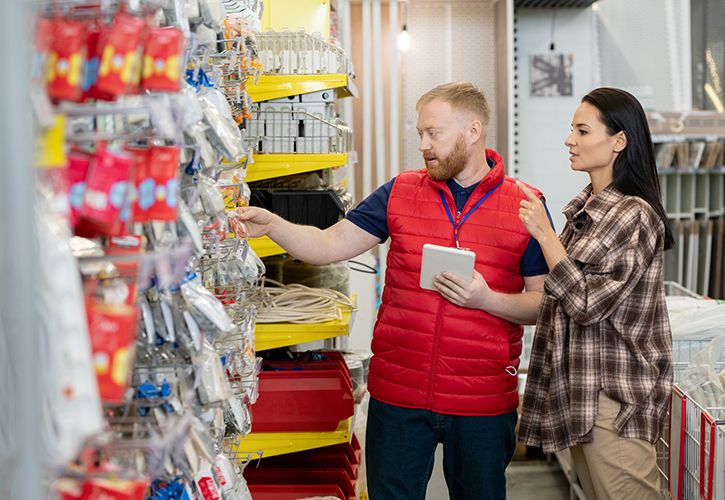UK DIY News
What's Next For The UK Home Improvement Industry?

Kelly Edwards discusses the UK home improvement sector.
With UK home improvements set to boom in 2025, retailers can embrace this increased interest and investment by enhancing their retail strategy to align with emerging trends and areas of continued growth.
The challenging economic climate means that consumers are turning to renovations and home improvements to save money and extend their homes' efficiency, suitability and sustainability.
From the growth in smart-home tech adoption to changing consumer habits, here are the key home improvement trends for your business to consider to optimise sales and maximise your strategy this year.
Investment in home improvement over moving house
Faced with skyrocketing mortgage rates, increases in stamp duty fast approaching and overall uncertainty in the housing market, homeowners are choosing to invest more in their current houses, rather than deciding to sell and move house.
21% of Brits plan to prioritise home improvements in 2025, likely driven by a desire to save money.
On average, renovating can often be cheaper than moving house, as homeowners avoid the associated costs of selling. Similarly, most homeowners plan to do at least some renovations in new houses, whether to update areas like bathrooms or kitchens or to add a personal touch to a home.
So, instead of wasting time selling their home and buying a new one just to undertake some degree of home improvement anyway, homeowners are focusing on upgrading their current houses.
Younger consumers, who purchased a property as a starter home, may now be facing the realisation that they’ll have to stay put and invest in renovation over looking for a larger home.
Creating a forever home may see home improvers looking to extend outwards or upwards, and create multifunctional spaces that can accommodate growing families over time.
For older homeowners, forward thinking home improvements are becoming increasingly popular. Ageing in place design prioritises accessibility. Rather than looking to sell and potentially downsize, many more mature homeowners are looking to stay in their homes for as long as possible, prioritising home improvements that support and adapt to ageing.
Some key areas in focus included bathroom renovations, with consumers opting for large, accessible walk-in showers over baths, and widening entryways and doors to accommodate accessibility further down the line.
Hybrid shopping experiences
While eCommerce continues to be a priority, offering convenience and flexibility, and the amplification of social commerce, last year saw a rise in in-store shopping.
According to the John Lewis 2024 report, 79% of shoppers chose to shop in-store as they wanted to touch and feel the products. For home improvers, this can be very important when it comes to choosing things like tiles, fabrics and paint to create a sensory experience for shoppers.
To create a hybrid shopping offering, there are a few key ways that you can help consumers have a seamless experience:
Digital kiosks in brick-and-mortar stores can combine physical and digital shopping. This will allow consumers to satisfy their sensory need to feel and experience a product in-store, then purchase online via a digital kiosk and get items delivered to their home address, therefore reducing the need to worry about transporting larger purchases from store to home.
Click-and-collection availability allows consumers to choose the best shopping and delivery experience for them.
While some home improvers can focus on renovations full-time, most will be working around a busy schedule and have limited spare time to dedicate to DIY.
Therefore we may see visits to shopping centres, outlets and retail parks increase this year to enable shoppers to combine visiting multiple shops in the same trip.
2025 will not only see IKEA arriving on the high street, with the opening of a flagship store on Oxford Circus, the Swedish retailer is also set to open a store in Brighton’s Churchill Square shopping centre this year, seemingly following the success of their store located in Hammersmith's Kings Mall shopping centre in London.
Similarly, John Lewis and other department stores have always prioritised prime shopping centre real estate locations, likely informed by the advanced sales data collection that shopping centres often invest in, allowing them track footfall alongside sales and help shopping malls advise retailers on key retail trends. Therefore, a retail presence in shopping centres could be a benefit for home businesses to help consumers shop efficiently.
Homes powered by smart tech
It’s no surprise that smart tech for the home continues to grow in popularity, and 2025 will see even further expansion in this category. With 80% of consumers owning at least one smart home product, home tech will likely move from a nice to have towards a central consideration when approaching home improvements.
From voice-activated devices to AI-powered home assistance, the breadth of smart-home tech available and accessible to consumers means they are turning their attention to smart-home interconnectivity. Understanding how various home tech works alongside each other, and its ability to communicate with each other to increase efficiency will appeal to consumers looking for convenience.
Increased reliance on smart tech in the home means its integration will be integral in most home renovation or improvement projects this year. Unsurprisingly, with increased demand comes innovation.
Smart home technology is ever evolving, so rising awareness of new products with the latest technology will be key. Highlighting products that are complementary, or use the same control functions, like an integrated app, will appeal to consumers looking for streamlined smart-tech.
Strong focus still on sustainability
Sustainability is still front of mind for home improvers, with many seeking out recycled or responsibly sourced products not just for interiors and decor, but for building materials too. Therefore, shouting about your sustainability credentials can help you stand out to home improvers.
Working towards a circular economy in retail can help to reduce waste by extending the use of products. Consider creating a recycling scheme, where consumers can return older models or products to your store, in exchange for a discount towards an updated version.
This allows you to reuse parts or material, or responsibly dispose of them, extending the life of the materials. If that’s not possible, giving consumers information and advice on how best to dispose of items as well as tips and tricks to maintain items to a high standard is a good alternative. This will encourage trust in your brand and your commitment to sustainability.
Efforts turning to energy-efficiency
With a keen focus on ensuring houses are energy-efficient, for both economic and environmental reasons, home improvers are looking to reduce their household energy waste while also reducing their energy costs.
When planning home improvement projects, investing in upgrading home insulation and installing solar panels are likely to continue to grow as consumers prioritise energy efficiency in their renovations. Generating their own energy, and ensuring that their homes are retaining heat are key focuses when it comes to large scale renovations.
On a smaller scale, consumers are making smart switches to aid energy efficiency in the home.
By simply swapping to LED lighting throughout their homes, DIYers are saving money and reducing their environmental impact. Draft exclusion and heat preservation are also top of mind, so using home decor, like thicker, heavier curtains or blinds can help to provide thermal insulation, to either enhance the impact of insulation or as a first step towards energy efficiency.
Final Thoughts
Overall, the future of the UK home improvement industry looks bright. With more investment into making changes to current homes rather than moving house, DIY and home improvement projects are set to increase.
While there are areas that continue to thrive, such as sustainability and smart technology, shopping habits are moving towards a hybrid preference meaning consumers are likely going to be combining online shopping with social commerce and in-store purchasing when it comes to renovations and home improvement.
In order to harness this increase, it’s important that retailers prioritise innovation in all areas of business and make data-driven decisions.
Source : Kelly Edwards
Image : shironosov / iStock / 1329039195
Insight DIY always publishes the latest news stories before anyone else and we find it to be an invaluable source of customer and market information.











































